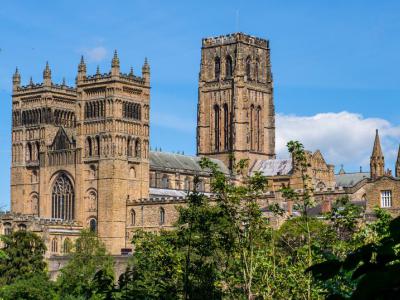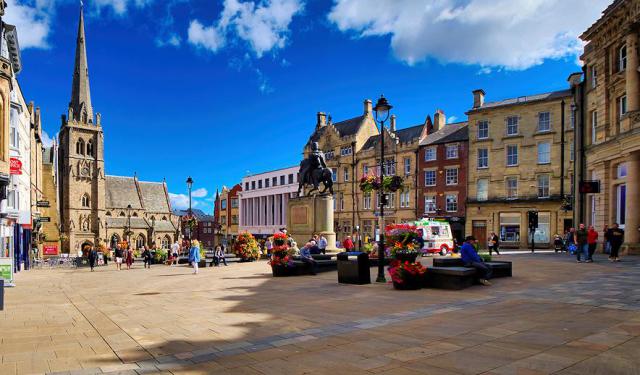Durham Cathedral, Durham (must see)
Long before Durham had a cathedral, a university, or even a postcode, there was Lindisfarne-also known as Holy Island. Perched off England’s northeast coast, it was the spiritual launchpad of the 6th century. Saints came, sermons were preached, and in time, Saint Cuthbert took the spotlight. He died in 687, but his story was far from over.
Jump ahead to 875, and in come the Vikings-loud, uninvited, and ready to shake things up. In response, the monks packed up Cuthbert’s body and hit the road-well, the dirt path. They wandered for years, relics in tow, dodging raiders and praying for peace. According to legend, guidance came not from angels, but from a milkmaid looking for a missing cow. Naturally. They led the monks to a high bend in the River Wear, where Cuthbert’s coffin refused to budge. Clearly, this was the place.
With local support, the monks raised a humble chapel of timber and wattle-“The White Church.” Pilgrims began trickling in, including King Canute, who was a prominent Viking king, who reportedly came barefoot. In 998, the White Church got a stone makeover. And by 1018, it was promoted to cathedral.
In 1093, the groundwork began for the grand cathedral that still towers over Durham today. Built by the new Norman rulers, it was designed not just as a place of worship, but as a fitting home for two of Britain’s most revered figures-Saint Cuthbert and the scholar-monk Bede.
Inside, the architecture starts to flirt with Gothic style-think ribbed ceilings, pointy arches, and an upper gallery that cleverly hides the building’s support system. But overall, it still feels Romanesque: solid, heavy, and more castle than cathedral in mood.
Cuthbert’s final resting place lies at the east end, surrounded by fragments of his original coffin and the company of 22 other interred souls-some under chapels, some beneath the transepts, and a few possibly photobombing your visit from the old meeting room, the chapter house.
In 1986, Durham Cathedral earned its stripes as a UNESCO World Heritage Site-hailed as one of Europe’s finest Norman buildings and a stone-and-mortar reminder that the Norman Conquest left more than just a line in the history books.
Jump ahead to 875, and in come the Vikings-loud, uninvited, and ready to shake things up. In response, the monks packed up Cuthbert’s body and hit the road-well, the dirt path. They wandered for years, relics in tow, dodging raiders and praying for peace. According to legend, guidance came not from angels, but from a milkmaid looking for a missing cow. Naturally. They led the monks to a high bend in the River Wear, where Cuthbert’s coffin refused to budge. Clearly, this was the place.
With local support, the monks raised a humble chapel of timber and wattle-“The White Church.” Pilgrims began trickling in, including King Canute, who was a prominent Viking king, who reportedly came barefoot. In 998, the White Church got a stone makeover. And by 1018, it was promoted to cathedral.
In 1093, the groundwork began for the grand cathedral that still towers over Durham today. Built by the new Norman rulers, it was designed not just as a place of worship, but as a fitting home for two of Britain’s most revered figures-Saint Cuthbert and the scholar-monk Bede.
Inside, the architecture starts to flirt with Gothic style-think ribbed ceilings, pointy arches, and an upper gallery that cleverly hides the building’s support system. But overall, it still feels Romanesque: solid, heavy, and more castle than cathedral in mood.
Cuthbert’s final resting place lies at the east end, surrounded by fragments of his original coffin and the company of 22 other interred souls-some under chapels, some beneath the transepts, and a few possibly photobombing your visit from the old meeting room, the chapter house.
In 1986, Durham Cathedral earned its stripes as a UNESCO World Heritage Site-hailed as one of Europe’s finest Norman buildings and a stone-and-mortar reminder that the Norman Conquest left more than just a line in the history books.
Want to visit this sight? Check out these Self-Guided Walking Tours in Durham. Alternatively, you can download the mobile app "GPSmyCity: Walks in 1K+ Cities" from Apple App Store or Google Play Store. The app turns your mobile device to a personal tour guide and it works offline, so no data plan is needed when traveling abroad.
Durham Cathedral on Map
Sight Name: Durham Cathedral
Sight Location: Durham, England (See walking tours in Durham)
Sight Type: Religious
Guide(s) Containing This Sight:
Sight Location: Durham, England (See walking tours in Durham)
Sight Type: Religious
Guide(s) Containing This Sight:
Walking Tours in Durham, England
Create Your Own Walk in Durham
Creating your own self-guided walk in Durham is easy and fun. Choose the city attractions that you want to see and a walk route map will be created just for you. You can even set your hotel as the start point of the walk.
Durham Introduction Walking Tour
According to the legend, it all started with a missing cow. Back in 995, a group of monks fleeing Viking raiders were hauling around the remains of Saint Cuthbert when their saintly cargo decided to stop moving. No matter how hard they tried, the bier wouldn’t budge-until a milkmaid chasing her lost dun cow wandered past. ("Dun" is a dull shade of brownish grey. ) The monks took the... view more
Tour Duration: 2 Hour(s)
Travel Distance: 2.6 Km or 1.6 Miles
Tour Duration: 2 Hour(s)
Travel Distance: 2.6 Km or 1.6 Miles




